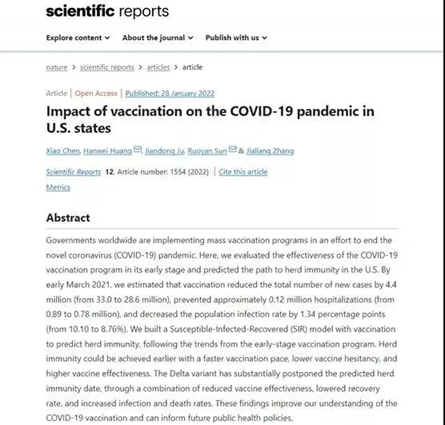Research paper Impact of Vaccination on the COVID 19 Pandemic: Evidence from U.S. States, co-authored by Ju Jiandong, Unigroup Chair Professor at Tsinghua PBCSF and Director of the Center for International Finance and Economics Research (CIFER), and Chen Xiao, Huang Hanwei, Sun Ruoyan and Zhang Jialiang, was officially published in Scientific Reports on 28 January 2022.

Special thanks to K.E. Warner and S. Mennemeyer.
Abstract
Governments worldwide are implementing mass vaccination programs in an effort to end the novel coronavirus (COVID-19) pandemic. Although the approved vaccines (Pfizer/BioNTech and Moderna) exhibited high efficacies in randomized controlled trials, their population effectiveness in the real world remains less clear, thus casting uncertainty over the prospects for herd immunity. In this study, we evaluated the effectiveness of the COVID-19 vaccination program and predicted the path to herd immunity in the U.S.
The study employed well-established reduced-form econometric techniques, commonly used to evaluate the effects of policies or events, to assess the impact of vaccination during the ongoing outbreak using data from all 50 U.S. states and the District of Columbia (DC). The actual proportion of the vaccinated population differs significantly across states over time, which provides the key variation to identify the impact of vaccination. The study collected state-level daily infection and hospitalization data in the U.S. By comparing the outcomes across states before and after the initiation of vaccination programs, the controlling impact of vaccination on the COVID-19 pandemic was evaluated. Using data from 12 October 2020 to 7 March 2021, the study estimated that vaccination reduced the total number of new cases by 4.4 million (from 33.0 to 28.6 million), prevented approximately 0.12 million hospitalizations (from 0.89 to 0.78 million), and decreased the population infection rate by 1.34 percentage points (from 10.10% to 8.76%).
To predict how the pandemic will develop with vaccines, a Susceptible-Infected-Recovered (SIR) model with vaccination to predict herd immunity was built. By curve fitting to predict the influence factors of herd immunity, it is observed that herd immunity could be achieved earlier with a faster vaccination pace, lower vaccine hesitancy, or higher vaccine effectiveness. However, for one thing, a certain proportion of the population might not receive the vaccination due to vaccine hesitancy. For another thing, only limited evidence is available regarding the efficacy or effectiveness of the vaccines against new coronavirus variants. All those factors greatly delayed or lead to cast doubt as to whether herd immunity can be achieved after all predicted by the model. These findings improve our understanding of the impact of COVID-19 vaccines and can inform future public health policies regarding vaccination.
Introduction of the Journal
Scientific Reports is a SCI journal affiliated to the Nature Publishing Group. It is an open access journal publishing original research from across all areas of the natural sciences, psychology, medicine and engineering. The impact factor of last 5-years is 5.134. According to Journal Citation Reports, JCR Scientific Reports is the 6th most-cited journal in the world, with more than 540,000 citations in 2020, and receives widespread attention in policy documents and the media.